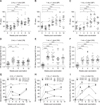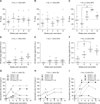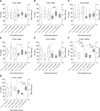Introduction
Foot-and-mouth disease (FMD) is a highly contagious disease in domestic animals that forms vesicles in the mouths and on the hooves of cloven-hooved animals, resulting in decreased livestock productivity. The disease has high lethality among young animals [9], therefore, it can produce large-scale economic losses. The FMD virus (FMDV) can be spread through the respiratory system or via contact, and the virus spreads very rapidly within a herd once an animal is infected. Once FMD occurs, to prevent the spread of the disease destroying the affected animal is inevitable. Hence, vaccination is important for the prevention of FMD spread. Following a large-scale occurrence of FMD in November 2010, all farm animals susceptible to FMD were vaccinated in Korea [11]. Occurrence of the disease then appeared to end, but FMD recurred in July, August, and December of 2014, and again from January to March in 2016 [12]. From 2000 onwards, both type A and type O FMDVs have occurred in Korea. A trivalent vaccine [O1 Manisa, A May97 (or A22 Iraq), and Asia1 Shamir] was used to prevent three serotypes that have occurred in Korea. The O/Jincheon/SKR/2014 FMDV occurred in Korea in 2014 and 2015. The type O, Mya98 lineage FMDV occurred in 2016, whereas, in 2017, type O, Ind2001d lineage and type A, sea-97 lineage FMDVs were circulating in East Asian countries (unpublished data). Since 2015, the O1 Manisa + O 3039 vaccine has been used for pigs, and, with the addition of A22 Iraq, for cattle. There is a contention within the Korean pig farming industry that economic losses occur as a result of delayed absorption of the oil-based vaccine. It is thought that residual adjuvant can cause the formation of denatured meat and granuloma in the animal's neck region after vaccination.
Hence, we recognized the need to develop a new locally available vaccine that would increase the matching rate for domestically occurring FMDV strains and would improve protective effects. In addition, we investigated whether using a new vaccine adjuvant could improve protective effects and decrease the occurrence of denatured meat in pigs. In a previous study, we had observed that a new experimental vaccine made with the ISA 201 adjuvant improved protective effects and immunogenicity in experimental animals, including pigs [17]. To determine whether that previous study's result could be similarly achieved with animals in the field, we investigated protective effects in cattle and pigs by monitoring the neutralizing antibody level after inoculation with the experimental ISA 201-adjuvant FMD vaccine.
For the experimental vaccine, an antigen was produced and purified from a BHK-21 cell culture of the O/Andong/SKR/2010 FMDV strain, which occurred domestically in Korea in 2010. To estimate its protective capabilities, we tested antibody production and neutralization effects on a homologous FMDV of the O/Andong/SKR/2010 strain and on a heterologous virus of the O/Jincheon/SKR/2014 strain that was recently isolated in Korea.
With regard to the current commonly used FMD vaccine, an initial vaccine is administered to 8-week-old pigs and cattle and an additional boosting inoculation is administered after another 4 weeks. The additional inoculation not only increases the possibility of denatured meat formation such as granulomatous lesions at the injection site, but it also causes economic problems in a practical sense as it increases the demand for labor on farms for application of the second vaccine [2]. Therefore, we conducted an analysis of the difference between the protective antibody levels obtained from a standard vaccine and a decreased dose volume vaccine, which resulted in a reduced amount of in vivo oil adjuvant administration. In addition, we analyzed the differences between protective effects in single- and double-vaccination groups.
Materials and Methods
Virus purification and inactivation
The FMDV O/Andong/SKR/2010 (AD virus) and BHK-21 cells were used for antigen preparation. For viral infection, the culture medium was replaced with serum-free Dulbecco's modified Eagle's medium (DMEM; Cellgro, USA) and the cells were inoculated with the virus. After 1 h of incubation at 37℃ in an atmosphere of 5% CO2, the extracellular viruses were removed. Twenty-four hours postinfection, the viruses were inactivated twice by treating with 0.003 N binary ethylenimine for 24 h in a shaking incubator and were concentrated with polyethylene glycol (PEG) 6000 (81260; Sigma-Aldrich, USA). The virus concentrate was layered on 15%–45% sucrose density gradients and centrifuged [13]. After ultracentrifugation, the bottom of the centrifuge tube was punctured and 1 mL fractions were collected. The presence of FMDV particles in a sample of each fraction was determined by using a lateral flow device (BioSign FMDV Ag; Princeton BioMeditech, USA). Prior to its use in the field experiment, the pre-PEG treatment supernatant was passed through a ZZ-R cell line at least twice to check that no cytopathic effect (CPE) had occurred, thus confirming the absence of live virus in the supernatant. Moreover, 100 µL of purified antigen was inoculated into C57BL/6 mice via the intraperitoneal (IP) route [15]. We confirmed the absence of viremia in mouse serum by performing real-time polymerase chain reaction at 3 day postchallenge.
Preparation of the experimental vaccines
The concentrated O/Andong/SKR/2010 FMDV antigens were diluted with Tris-NaCl buffer (pH 7.6) and then added to Montanide ISA 201 VG (ISA 201; Seppic, France). The ratio of adjuvant volume to total volume was 50:50. The mixture was stirred at 300 rpm/min for 10 min at 30℃ in a water incubator in order to form a water-in-oil-in-water blend. The stability of the vaccines was tested by the using the dropping method [10].
Immunization of the animals
For the field experiment, 8-week-old cattle and pigs in three farmhouses were divided into three groups, each group containing 20 pigs or 5 cows (Table 1). Groups A for pigs and D for cattle received a single 10 µg/2 mL vaccine. Groups B for pigs and E for cattle received a single 10 µg/1 mL vaccine. Group C for pigs and F for cattle received a second 10 µg/1 mL vaccine 4 weeks after the initial 10 µg/1 mL vaccination. Pig serum was collected before the initial vaccination and at the 2nd, 3rd, 4th, 8th, and 12th week post vaccination (wpv). Bovine serum was collected before the initial vaccination, and at the 2nd, 4th, 8th, and 12th wpv. Animal experiments were performed in strict accordance with recommendations in the Guide for the Care and Use of Laboratory Animals of the Animal and Plant Quarantine Agency. All animal procedures were approved by the Institutional Animal Care and Use Committee of the Animal and Plant Quarantine Agency of Korea (IACUC No. 2016-343). All possible efforts were made to minimize animal suffering.
ELISA for the detection of structural protein antibodies
For the detection of structural protein (SP) antibodies in sera, PrioCHECK FMDV type O (Prionics, Switzerland) was used. The absorbance of the enzyme-linked immunosorbent assay (ELISA) plate was converted to a percent inhibition (PI) value. When the PI value was 50% or above, the animals were regarded as antibody positive.
Virus neutralization test
Titers of neutralizing antibodies in the serum were measured by applying a virus neutralization test (VNT). Serum samples were collected from animals after vaccination and were heat-inactivated at 56℃ for 30 min. The cell density was adjusted to form a 70% monolayer, and the test was conducted by using a two-fold dilution of sera. Following incubation of the test serum with FMDV (O/Andong/SKR/2010 [=O/SKR(KOR)/Nov/2010, AD] or O/Jinchon/SKR/2014 [=O/SKR(KOR)/Dec/2014, JC]) 100 tissue culture infectious dose (TCID)50/0.05 mL for 1 h [17], LF-BK (bovine kidney) cells were added to the plate and incubated for 2–3 days [6]. The CPE was checked to determine the titers, which were calculated as the log10 of the reciprocal antibody dilution to neutralize 100 TCID50 of virus [5]. When the neutralizing antibody was 1.2 or above, the sera were regarded as antibody positive.
Results
Immune responses in pigs immunized with the experimental FMD vaccine
After vaccinating pigs and cattle, serum SP and virus neutralizing (VN) antibodies to the FMDV were observed (Figs. 1, 2, 3, 4). Group A (panels A, D, and G in Fig. 1), which received the single 10 µg/2 mL vaccination, had an SP antibody-positive rate of 52.6% at the 3rd wpv. The mean titer decreased at the 4th and 8th wpv, but the antibody-positive rate recovered (61.1%) at the 12th wpv. Similarly, group B (panels B, E, and H in Fig. 1), which had received the single 10 µg/1 mL vaccination, showed an SP antibody-positive rate of 50.0% at the 3rd wpv, and the rate continued to increase until the 12th wpv. Group C (panels C, F, and I in Fig. 1), which received an additional 10 µg/1 mL booster vaccination at the 4th week after the initial 10 µg/1 mL vaccination had the highest SP antibody-positive rate at the 8th wpv, indicating the effectiveness of the additional vaccination. However, the effect did not last and the SP antibody-positive rate had decreased by the 12th wpv.
The neutralizing antibody decreased in the single vaccination groups after the 3rd wpv, showing results that were similar to those obtained via ELISA (panels A–D in Fig. 3). Overall, group C, which was inoculated twice with the 10 µg/1 mL vaccine, had a higher antibody titer level (antibody-positive rate by VNT) than that in the 10 µg/1 mL single-dose group. However, the antibody titers in the 10 µg/1 mL-vaccinated groups showed a downward trend after the 4th wpv. Following the additional vaccination at the 4th wpv, the double 10 µg/1 mL-vaccinated group showed a protective antibody level (> 1:45 VNT, 60%–90%) that lasted until the 12th wpv.
Immune responses in cattle immunized with the experimental FMD vaccine
Two-month-old cows were vaccinated by using the same vaccine levels and doses as those used for the pigs (Figs. 2 and 3). The cows in group D (panels A, D, and G in Fig. 2), which received the single 10 µg/2 mL vaccination, had an SP antibody-positive rate of 60% at the 2nd wpv. However, the proportion of animals with positive reactions gradually decreased afterward. The group E cows (panels B, E, and H in Fig. 2), which received the single 10 µg/1 mL vaccination, had an SP antibody-positive rate of 20%–40% over the full observation period. In group F cows (panels C, F, and I in Fig. 2), which had received two 10 µg/1 mL vaccinations, the antibody-positive rate increased after the additional vaccination, and all animals in the group had positive PI values after the 8th wpv.
The neutralizing antibody titer in cow serum was measured before and after vaccination. In group D cows (10 µg/2 mL), the number of animals with had a positive neutralizing antibody gradually increased with time post vaccination. However, group E cows (single 10 µg/1 mL vaccination) did not exhibit an upward trend. For the twice-vaccinated group F cows, the neutralizing antibody titer increased after the additional vaccination, and all animals in the group had protective antibody titer levels (> 1:45) that persisted until the 12th wpv.
Immune responses against the domestically occurring heterologous FMDV
When measuring the neutralizing antibody titers against the FMDV (O/Jincheon/SKR/2014, JC virus) that occurred in Jincheon City in December 2014, the antibody titer was low in most groups (Fig. 4). Similar results were observed in the single- and twice-vaccinated groups. Among the pig groups, the 10 µg/1 mL once-vaccinated group (group B) contained animals that had developed some neutralizing antibodies, but most pigs exhibited a low neutralizing antibody level. In the twice-vaccinated cattle, the neutralizing antibody level increased slightly after the second vaccination and only decreased at 12th wpv. The results reveal a low level of antibody formation against the heterologous virus, even though it was of the same topotype that had occurred domestically in December 2014.
Discussion
Adjuvants increase the effects of a vaccine by stimulating an immune reaction. Oil, alum salts, and virosomes are mainly used as adjuvants because they increase the immune reaction by acting with lipopolysaccharides, double-stranded RNA, and single-stranded RNA. Hence, the choice of adjuvant is important in determining the effectiveness of a vaccine [78]. However, in the case of the oil adjuvant that is widely used in animals, local lesions at the injection site such as edemas, inflammatory reactions, and necrosis have been reported [118]. On farms, there are further issues related to the presence of denatured meat. For other virus vaccines, reducing vaccine volume to a minimum amount has been proposed as a method to decrease the side effects arising from the adjuvant. In particular, a previous study reported that inoculating with a reduced dose of a smallpox vaccine could maintain the vaccine's effectiveness and control morbidity at the same time [3]. With respect to the FMD vaccine, discarding denatured meat such as granuloma lesions resulting from residual adjuvant has been reported to result in a huge economic loss every year in the pig farming industry. There is also the problem that pigs show low immunogenicity and protective effects compared to those in cattle. Hence, the currently used FMD vaccine requires an improvement in its effectiveness; such an improvement can involve changing the vaccine components and/or amounts. Moreover, these problems should be solved in order to prevent the occurrence and spread of FMD. We previously confirmed the possibility of using an effective new vaccine formulation through an experiment involving specific adjuvant mixtures [14]. In the present study, we tested the field applicability of an experimental vaccine made with the adjuvant ISA 201 by vaccinating field animals (pigs and cows) and monitoring their immunogenicity. The FMD vaccine with ISA 201 adjuvant has been shown to provide a rapid cellular immune response in vaccinated animals [7], and in our previous study, we suggested that the ISA 201-based vaccine was more effective than the standard adjuvant FMD vaccine [14].
In the field experiment on pigs, the groups that received half (i.e., 10 µg/1 mL) of the original dose volume showed similar or higher values of SP antibody in ELISA results. Similar results were observed for the neutralizing antibody. It is conjectured that, although there were identical amounts of antigen injected, a larger amount of antigen was more promptly exposed in the 10 µg/1 mL inoculation group than in the 10 µg/2 mL inoculation group because less oil adjuvant would have entered the animal in the former group. In addition, we were able to confirm that the effects in the half-volume dose pigs did not diminish up to the time of slaughter, even though we reduced the dose volume but maintained the previously recommended amount of vaccine antigen.
However, no noticeable boosting effect from the second vaccination was observed in the SP antibody and neutralizing antibody levels for pigs. In contrast, in the field experiment with cattle, the SP antibody titer developed faster than in pigs and the boosting effects also greatly increased after the second vaccination. A similar phenomenon was observed in the neutralizing antibody levels. The results indicate that the effects of the second vaccination were greater in cattle than in pigs. Since serological reactivity was observed after the second vaccination, secondary vaccination will be required in cattle.
We expect to improve further the experimental FMD vaccine made with ISA 201 adjuvant for a solution of field problem. As we only checked the injection site with unaided eyes (data not shown), follow-up studies involving pathological examination might be needed. In a previous study [14], immunization in pigs and goats with the experimental vaccine using the same antigen and adjuvant was observed to protect against a homologous challenge virus. Follow-up studies to determine in vivo field protection will be required in the presence of an actual FMD infection, which can provide information on interference phenomena arising from diverse vaccines being used to inoculate young animals soon after birth and on maternal transfer of the antibody [416].




 PDF
PDF ePub
ePub Citation
Citation Print
Print







 XML Download
XML Download